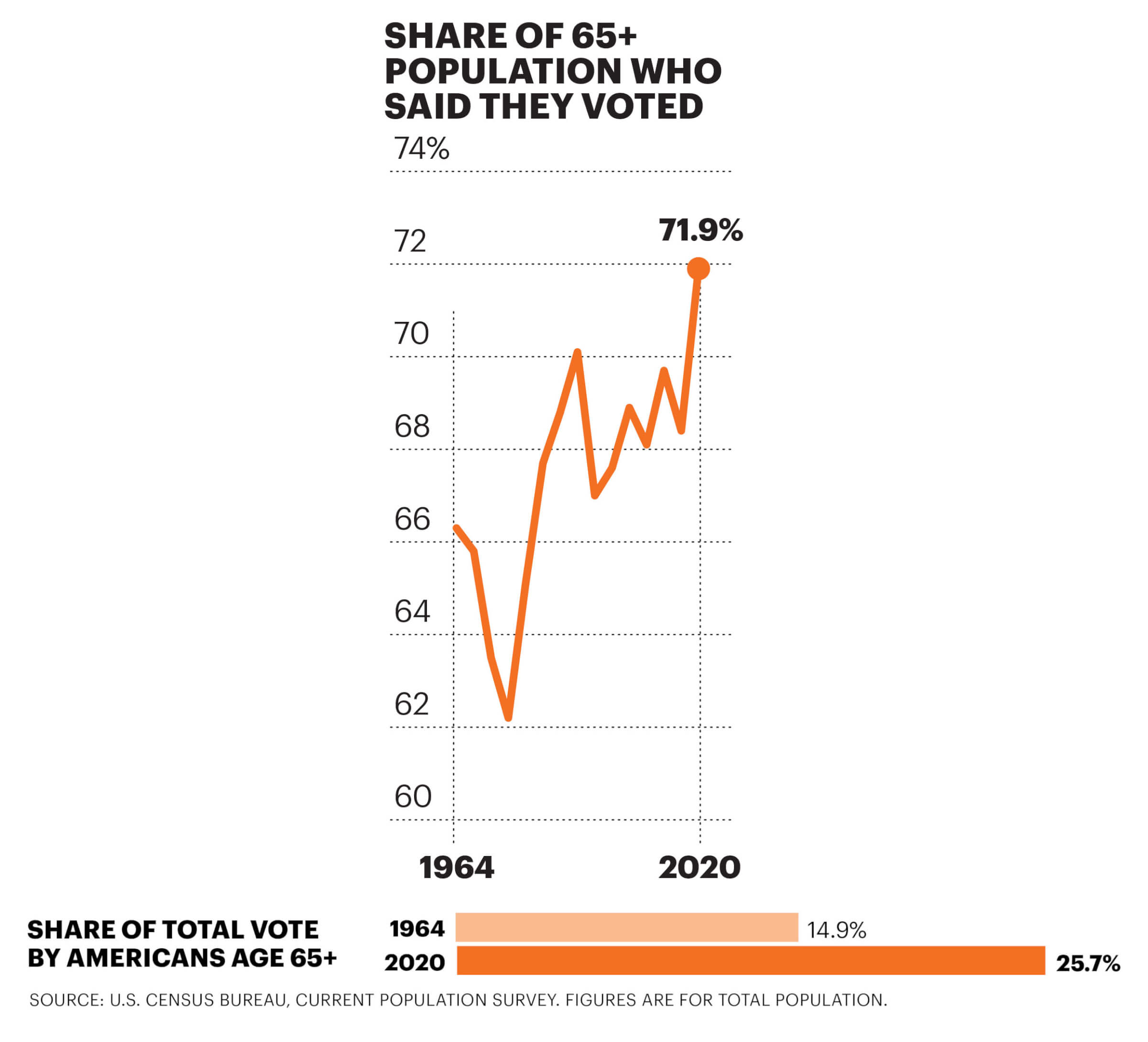In the News Special Report
FOR OLDER VOTERS, A GROWING VOICE
Surprisingly, that wasn’t always the case

SOURCE: U.S. CENSUS BUREAU, CURRENT POPULATION SURVEY. FIGURES ARE FOR TOTAL POPULATION.
WHEN IT COMES to being heard at the ballot box, America’s older voices are getting louder.
That older voters turn out in numbers well above other age groups is a truism in electoral politics—“almost like a law,” says Michael McDonald, a professor of political science at the University of Florida.
But it hasn’t always been that way: In decades past, younger cohorts voted at higher percentages than those 65 and older. It wasn’t until the 1980s and ’90s that turnout among people 65-plus eclipsed other age groups tracked by the U.S. Census Bureau. Since then, the gaps between older voters and younger ones have generally grown.
The reasons for the change are both simple—increasing voter-outreach efforts by groups focused on the needs of older Americans—and complex: a deeply felt sense of civic involvement among those who became active in the 1960s and ’70s. And over the years, voting has become easier, with mail ballots and expanded in-person options more prevalent.
What’s more, older people know voting matters—a lot.
“There are two issues that absolutely dominate the interests of our constituency: Medicare and Social Security,” says Nancy LeaMond, AARP executive vice president and chief advocacy and engagement officer. “It’s also very clear that elected officials have a big role to play in those programs.”
In the 2020 presidential election, 71.9 percent of Americans 65-plus said they voted, according to Census Bureau surveys. For those 45-64, it was 65.5 percent; for those 25-44, 55 percent; and for those 18-24, 48 percent. That figure for voters 65-plus was the highest it’s been since the Census Bureau started tracking the numbers in 1964.
The pattern holds true in midterm elections as well: Voting by those 65-plus has been increasing and outpacing other age groups.
Polls conducted in 2024 for AARP confirm that. Asked to rate themselves on a scale of 1 to 10 on their motivation to vote in November, 91 percent of older voters in Ohio gave themselves a 10; the numbers steadily dropped for younger age groups—to 69 percent for the youngest one. The pattern held in other states.
At the same time the older voter turnout percentage has increased, the number of people in that demographic has expanded. More people voting at higher rates means the size—and relative strength—of the 65-plus voting bloc is much bigger than it was.

A TALE OF TWO STATES
None of this surprises Steve Simon, the Democratic secretary of state in Minnesota, or David Scanlan, the Republican one in New Hampshire. Older voters in their states vote in higher percentages than peers in any other state.
The states have very different voting systems. The Cost of Voting Index, which tracks the availability of voting options such as no-excuse absentee ballots and expanded in-person voting hours, puts Minnesota in the top third and New Hampshire near the bottom.
Both officials point to strong civic culture as vital to keeping turnout high. With its first-in-the-nation presidential primaries and midnight voting in some communities, New Hampshire has a history that prizes participation. “People know when the Election Day is, and they get charged up for it,” Scanlan says.
Scanlan notes that many of the nation’s oldest voters today came of age during the 1960s, when political activism—and turnout—rose. McDonald, the Florida professor, says that if you vote once, you’re much more likely to vote again—both your sense of civic duty and your partisanship kick in. And campaigns are much more likely to pester you to get to the ballot box at the next—and every—election.
AARP won’t suggest how you vote—but strongly encourages you to do so.
The reason is simple: That big bloc of older voters that plays a disproportionate share in deciding elections has a lot riding on the actions of who wins. It’s not just Social Security and Medicare but also prescription drug prices, family caregiving costs, long-term care—all topics that are “front and center for older voters,” says Khelan Bhatia, AARP voter engagement director. “It’s very real for them.”